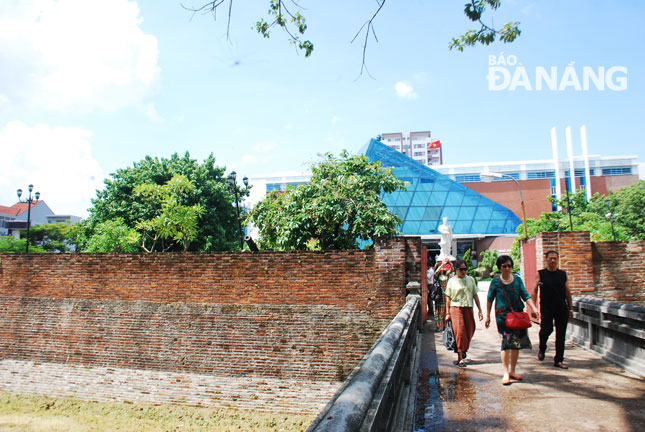Dien Hai Citadel expected to become very inviting place in city
The restoration and embellishment of the Dien Hai Citadel which is the only one special national-level relic site in Da Nang are underway. This work has been attracting great deal of public attention for its great significance to the city in recent times. Besides, the city authorities will approve the establishment of a square, with the Dien Hai Citadel being at the central position.
 |
| The Museum of Da Nang incorporates the reconstructed walls of the Dien Hai Citadel |
The above-mentioned remarks were made by Director of the city’s Culture and Sports Department Huynh Van Hung during his recent interview with the DA NANG Newspaper.
Work started on the restoration and embellishment of the citadel late March, and now, everything is on right track.
The ongoing 1st stage of the project, worth a total estimated cost of over 102.7 billion VND (over 4.4 million USD), is now progressing well.
Under this stage, a total of 80 families living near the citadel’s western walls have already moved out of the site to their new residential areas, and the restoration of the citadel’s damaged walls and trenches has been completed to date. Meanwhile, a stroll garden and other auxiliary facilities are expected to be completed by late next month.
The 2nd stage of the project, with a focus on facilities inside the citadel, will be deployed right after the Museum of Da Nang is moved out of the citadel site to the former headquarters of the municipal People’s Committee at 42 Bach Dang. The relocation of the museum is scheduled to be carried out in 2020.
According to the historical documents, inside the citadel were a food storage, an ammunition depot, a military camp, a flag pole and other important facilities. Unfortunately, all of them have totally been ravaged by time and war.
Between late September and early October, a delegation of representatives from relevant local agencies, led by Director Hung, made their successful France trip during which they collected artifacts related to the citadel and the Anti-French Resistance War in Da Nang during the 1858-1860 period.
Thanks to the recommendation made by the French Embassy in Viet Nam, the Da Nang delegation paid visits to such document storage facilities in France as the École française d'Extrême-Orient (EFEO), the Archives of the French Army, and the Army Museum which is a national military museum of France.
 |
| Director of the city’s Culture and Sports Department Huynh Van Hung looking for needed information on the Dien Hai Citadel at the École française d'Extrême-Orient |
At these places, the Da Nang guests collected and photocopied hundreds of special documents about the citadel and the Anti-French Resistance War in Da Nang during the 1858-1860 period.
Noticeable amongst them were a sketch attached to a map on the defence layout of the citadel, documents on the process of using the venue during the French occupation period, and regular reports on the development of the war in Da Nang by French military officers at the battlefield.
In addition, the Da Nang guests took a copy of drawings on the Hai Van Gate and north-south route dating back to 1470, connecting the Imperial City of Hue, the ancient capital of Viet Nam, with the Hai Van Gate during the early days of the battle against the French force. These collected objects are of great significance to the ongoing the restoration and embellishment of the Hai Van Gate.
Covering a total of 10ha belonging to Thanh Thang and Hai Chau 1 wards in Hai Chau District, a much-awaited square, with the citadel in its centre position, will border Ly Tu Trong to the north, Quang Trung to the south, Nguyen Chi Thanh to the west, and the Han River to the east.
The city leaders have basically agreed on the adjustments to a design for the establishment of the square, with an emphasise on creating an entrance to Dien Hai from Quang Trung Street, developing traffic infrastructure around the square, building an underground parking area at the existing tennis court on Bach Dang Street, and upgrading the landscape architecture at a residential area to west of the citadel and neighbouring streets.
During the ongoing deployment of the project, the number of visitors to the Museum of Da Nang, which incorporates the reconstructed walls of the citadel is keeping an upward trend.
This inviting place welcomed more than 220,000 visitors from both home and abroad between January and February, and this figure is likely to have reached 300,000 by late this year, up 30% against last year.
Once the restoration and embellishment project is completed, the citadel will become one of very inviting places in the city and a ‘do not miss’ site for visitors to learn more about the culture and history of Da Nang.